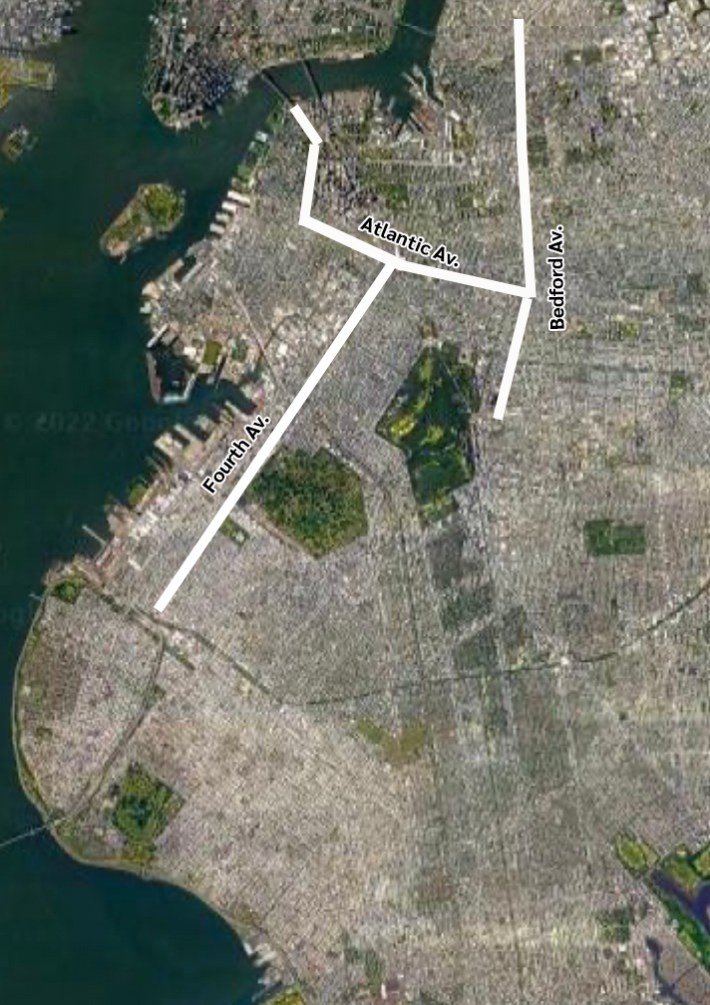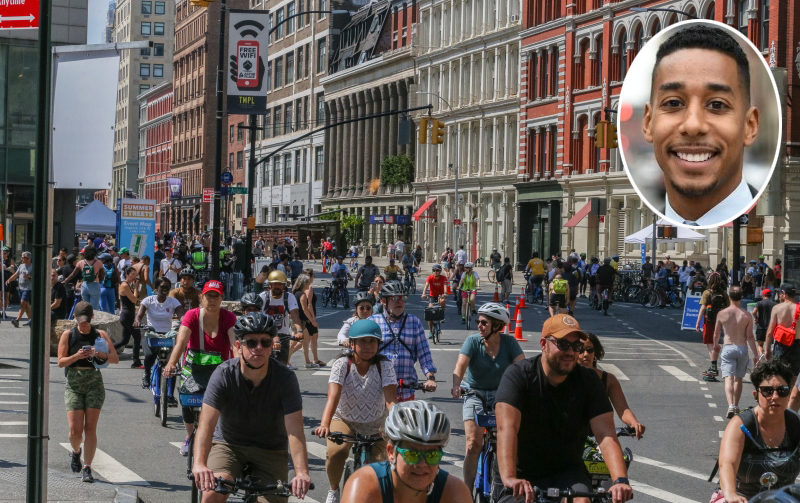Spread Summer Streets, it's the Brooklyn way.

The borough presidents of both Brooklyn and Queens have already asked the Department of Transportation to expand the popular summer extravaganza to their neck of the woods — but Brooklyn Borough President Antonio Reynoso has started to put some meat on that bone, calling for a car-free corridor in his borough that is at least as long, if not longer, than the six-and-a-half-mile version in Manhattan.
To Reynoso, the expansion of the 14-year-old Summer Streets initiative has to go beyond the current patchwork of pandemic-era Open Streets that stretch for only some blocks.
"It can’t be an Open Street and the six, seven, or eight blocks that we do for those. It has to be something that differs from that, and the only way to do that is to allow for continued growth and opportunity," Reynoso told Streetsblog. "We have to think about, long-term, having a route that is as long if not longer than the one Manhattan does."
Currently, Summer Streets bars car traffic between the Brooklyn Bridge in Lower Manhattan and East Harlem on three consecutive Saturdays in August from 7 a.m.-1 p.m., mostly along Park Avenue and connecting streets. (DOT counts it as eight miles by including the Brooklyn Bridge, even though the span's pedestrian boardwalk and protected bike lane are open year-round).
Reynoso and his Queens counterpart Donovan Richards asked DOT Commissioner Ydanis Rodríguez in September to expand Summer Streets to their boroughs — Brooklyn being the city's most populous and Queens, the largest by area. But the Adams administration has not yet indicated any such plans.
A DOT spokesman said the agency is looking into possible expansions.
"DOT is incredibly proud to have expanded this year’s Summer Streets and we are actively exploring future expansions," Tomas Garita said in a statement. "We encourage all community partners to become involved with us as we continue this work in the future."
That's exactly what the two borough presidents are doing by pushing City Hall to get moving now, so agency planners can zero in on the best locations and can meet with community boards and electeds as part of the sometimes-lengthy outreach process.
Good options for Summer Streets would be roadways that stretch across most or all of the borough, said Reynoso.
"Corridors that are borough-wide would be ideal," he said. "What streets go east to west, north to south that would be meaningful for Brooklyn, so the Bedford Avenues, the Atlantic Avenues of the world."
The pol wanted to leave it up to DOT to propose actual spots.
"That has to happen three months before ... so that we’re not having a conversation about folks being surprised," he said.
He said he would provide funding from his budget to help make it happen.
"I am committed to resourcing it, if need be, to make this possible," Reynoso told Streetsblog.
DOT allocates about $500,000 to produce Summer Streets, which includes a wealth of programming like basketball games, workshops, marching bands, and band performances.
The department has been hobbled by a high vacancy rate and Mayor Adams has ordered agencies cut about half of the city's open civilian roles citing budget shortfalls.

But even if resources are tight, advocates argued that officials could simply close off roads for Summer Streets in the boroughs without setting up expensive events around them.
“For me just having the street be open for pedestrians and cyclists and so forth in itself has value," Reynoso said. "The programming is an added value, but it’s not a necessary or an essential part of making this program successful."
Jackson Chabot, the director of public-space advocacy of Open Plans (a sister organization of Streetsblog), agreed that the initial expansion is really just about the space, not the stuff.
"Literally just open up the streets, we don’t need the extensive programming, really, that we see in Manhattan," he said, adding that many Brooklynites already enjoy a car-free Fourth Avenue in the hours after the New York City Marathon passes through and before cops reopen the thoroughfare to car traffic.
"We know that people will use the streets" without elaborate programming, Chabot said.
One Queens safe streets advocate said that DOT should use the next Summer Streets to make good on its pledge to "reimagine streets as public space," by closing off prominent streets or experimenting with ideas like superblocks.
"I would like them to pick a street that would make a statement," said Pedro Rodriguez, a volunteer advocate with Transportation Alternatives based in Forest Hills. "For example, Queens Boulevard, not just because of how major of a throughway it is, but also because it’s a street that used to be known as the Boulevard of Death."
Summer Streets dates back to 2008 and is modeled after events like the Ciclovía in Bogotá, Colombia, and the Paris Plage in France. After a two-year hiatus during the Covid-19 pandemic, Mayor Adams revived it and extended it by two miles to E. 109th Street, but Hizzoner didn't add more hours or days as many have long hoped.






